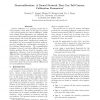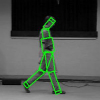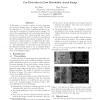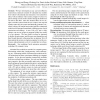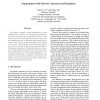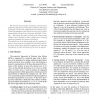ICCV
1999
IEEE
15 years 1 months ago
1999
IEEE
Camera calibration is a primary crucial step in many computer vision tasks. In this paper we present a new neural approach for camera calibration. Unlike some existing neural appr...
ICCV
1999
IEEE
15 years 1 months ago
1999
IEEE
We propose a Bayesian framework for representing and recognizing local image motion in terms of two primitive models: translation and motion discontinuity. Motion discontinuities ...
ICCV
1999
IEEE
15 years 1 months ago
1999
IEEE
Slanted surfaces pose a problem for correspondence algorithms utilizing search because of the greatly increased number of possibilities, when compared with frontoparallel surfaces...
ICCV
1999
IEEE
15 years 1 months ago
1999
IEEE
Existing sequential feature-based registration algorithms involving search typically either select features randomly (eg. the RANSAC[8] approach) or assume a predefined, intuitive...
ICCV
2001
IEEE
15 years 1 months ago
2001
IEEE
In this paper, we present a system to detect passenger cars in aerial images where car appears small. We post the detection as a 3D object recognition problem to account for the v...
ICCV
2001
IEEE
15 years 1 months ago
2001
IEEE
: We have developed an easy and cost-effective system that constructs textured 3D animated face models from videos with minimal user interaction. Our system first takes, with an or...
ICCV
2001
IEEE
15 years 1 months ago
2001
IEEE
We describe a novel viewpoint-lighting ambiguity which we call the KGBR. This ambiguity assumes orthographic projection or an affine camera, and uses Lambertian reflectance functi...
ICCV
2001
IEEE
15 years 1 months ago
2001
IEEE
We propose a method of image segmentation by integrating pairwise attraction and directional repulsion derived from local grouping and figure-ground cues. These two kinds of pairw...
ICCV
2001
IEEE
15 years 1 months ago
2001
IEEE
We cast the problem of multiframe stereo reconstruction of a smooth shape as the global region segmentation of a collection of images of the scene. Dually, the problem of segmenti...
ICCV
2001
IEEE
15 years 1 months ago
2001
IEEE
We describe the principles of building a moving vision platform (a Rig) that once calibrated can thereon self-adjust to changes in its internal configuration and maintain an Eucli...
